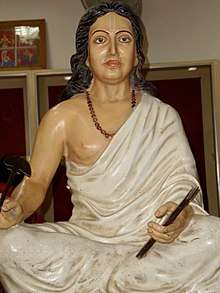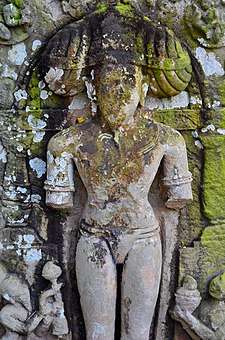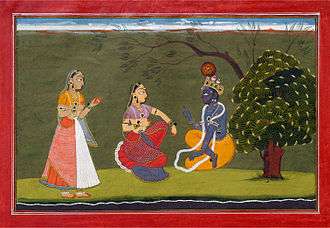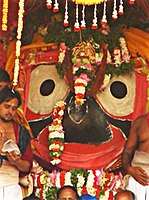Jayadeva
Jayadeva (pronounced [dʑɐjɐˈdeːʋɐ], born c. 1170 CE), also known as Jaidev, was a Sanskrit poet during the 12th century. He is most known for his epic poem Gita Govinda[2] which concentrates on Krishna's love with the cowherdess, Radha in a rite of spring.[3] This poem, which presents the view that Radha is greater than Krishna, is considered an important text in the Bhakti movement of Hinduism.[4]
Jayadeva | |
|---|---|
 Jayadeva's idol at Kendubilwa, Odisha | |
| Personal | |
| Born | c. 1170[1] |
| Died | c. 1245[1] |
| Religion | Hinduism |
| Philosophy | Vaishnava |
| Religious career | |
| Literary works | Gita Govinda |
| Part of a series on |
| Sikhism |
|---|
 |
|
|
Practices
|
|
|
General topics
|
Little is known of his life, except that he was a loner poet and a Hindu mendicant celebrated for his poetic genius in eastern India. Jayadeva is the earliest dated author of hymns that are included the Guru Granth Sahib, the primary scripture of Sikhism – a religion founded in the Indian subcontinent centuries after his death.[2][1]
Biography
A Brahmin by birth, the date and place of Jayadeva's birth are uncertain (see Jayadeva birth controversy). The Gitagovinda suggests that he was born in the "Kindubilva" village: scholars of Odisha, Bengal and Mithila have variously identified this place with a present-day village in their own region, including Kenduli Sasan near Puri in Odisha, Jaydev Kenduli in Birbhum district, and or the village of Kenduli Kenduli near Jhanjharpur in Mithila (Bihar).[5] Recent studies show scholars still disagree on the issue.[6] Jayadeva, a wanderer, probably visited Puri at some point and there, according to tradition, he married a dancer named Padmavati though that is not supported by early commentators and modern scholars.[7]

The poet's parents were named Bhojadeva and Ramadevi. From temple inscriptions it is now known that Jayadeva received his education in Sanskrit poetry from a place called Kurmapataka, possibly near Konark in Odisha.[8][9]
Historical records on Jayadeva's life
Inscriptions at Lingaraj temple, and the more recently discovered Madhukeswar temple and Simhachal temple that were read and interpreted by Satyanarayana Rajguru have shed some light on Jayadeva's early life. These inscriptions narrate how Jayadeva had been a member of the teaching faculty of the school at Kurmapataka. He might have studied at Kurmapataka as well. It must have been right after his childhood education in Kenduli Sasan that he left for Kurmapataka and gained experience in composing poetry, music and dancing.[8][9][10]
Literary contributions

A few poems of Jayadeva written in archaic Odia have been published by the Directorate of Culture, Odisha. They describe the romance of Radha-Krishna and contain ideas very similar to those used in the Gita Govinda.[11]
Two hymns of Jayadeva, have been incorporated in the Guru Granth Sahib, the holy book of the Sikh religion.[2][1]
The hymns are written in a mixture of Sanskrit and eastern Apabhramsha.[12] There are records narrating how Jayadeva's work had a profound influence on Guru Nanak during his visit to Puri.[13][14][15]
See also
- Bhagat Jayadeva Hymns in Guru Granth Sahib
- Sanskrit literature
- Bhakta Jayadeva, 1938 and 1961 Telugu language films
- Kavi Joydev, a 1941 Bengali film about Jayadeva by Hiren Bose
- Joydeb, a 1965 Bengali film about Jayadeva by Pinaki Mukherjee
Notes
- Pashaura Singh (2003). The Bhagats of the Guru Granth Sahib: Sikh Self-definition and the Bhagat Bani. Oxford University Press. pp. 9, 116–123. ISBN 978-0-19-566269-6.
- Max Arthur Macauliffe (2013). The Sikh Religion: Its Gurus, Sacred Writings and Authors. Cambridge University Press. pp. 4–9. ISBN 978-1-108-05548-2.
- Miller 1977, preface ix.
- http://orissa.gov.in/e-magazine/Orissareview/2008/May-2008/engpdf/Poet39-40.pdf
- Miller 1977, p. 4.
- William M. Reddy (2012). The Making of Romantic Love: Longing and Sexuality in Europe, South Asia, and Japan, 900-1200 CE. University of Chicago Press. p. 257. ISBN 978-0-226-70628-3.
- Miller 1977.
- The Orissa Historical Research Journal. Superintendent of Research and Museum. 1993.
- Harish Chandra Das; State Level Vyasakabi Fakir Mohan Smruti Samsad (2003). The cultural heritage of Khurda. State Level Vyasakabi Fakir Mohan Smruti Samsad.
- Angelika Malinar; Johannes Beltz; Heiko Frese (1 September 2004). Text and context in the history, literature, and religion of Orissa. Manohar. ISBN 978-81-7304-566-0.
- Mishra, Nilamani, ed. (1973). Odia Bhajana (in Odia). 3 (2 ed.). Bhubaneswar, Odisha: Directorate of Culture, Odisha. pp. iv–v.
- Dass, Nirmal. Songs of the Saints from the Adi Granth. State University of New York Press. p. 130. ISBN 978-0791446836.
- Encyclopaedia of Education, Culture and Children's Literature: v. 3. Indian culture and education. Deep & Deep Publications. 2009. pp. 49–. ISBN 978-81-8450-150-6.
- Harish Dhillon (1 January 2010). Guru Nanak. Indus Source. pp. 88–. ISBN 978-81-88569-02-1.
- Navtej Sarna (1 April 2009). THE BOOK OF NANAK. Penguin Books Limited. pp. 33–. ISBN 978-81-8475-022-5.
References
- Miller, Barbara Stoler (1977). Lovesongs of Krishna, the Gītagovinda of Jayadeva (1st Indian ed.). New York: Columbia University Press. ISBN 0231040288.CS1 maint: ref=harv (link)
External links
| Wikisource has the text of the 1905 New International Encyclopedia article Jayadéva. |
- Sanskrit Scholars of Odisha (pdf)
- . Encyclopedia Americana. 1920.

